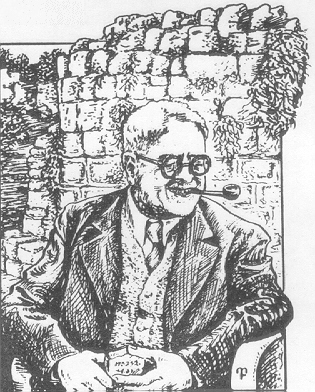George Andrew Reisner (1867–1942) -- By: Milton C. Fisher
Journal: Bible and Spade (Second Run)
Volume: BSPADE 05:1 (Winter 1992)
Article: George Andrew Reisner (1867–1942)
Author: Milton C. Fisher
BSP 5:1 (Winter 1992) p. 2
George Andrew Reisner (1867–1942)
Each of our scholar-heroes has been outstanding in some particular manner, noted for some special contribution to the fascinating story of archaeology as it relates to the Bible. Although as an Egyptologist Reisner’s work in the Holy Land itself was very limited, his gift to the science of field archaeology was in the refinement of the techniques of excavation. Careful work and record keeping procedures which he perfected in Egypt were, in a manner reminiscent of the great Flinders Petrie, applied to the excavation he conducted in partnership with the architecturally trained Clarence S. Fisher, at Samaria.

G. A. Reisner with an ostracon, sitting at Samaria’s West Gate round tower.
So exemplary was this Palestinian excavation at the Israelite capital (that is, the Northern Kingdom) that the “Reisner-Fisher method” of digging and recording became the standard. For three decades to follow it was the procedure officially prescribed by the government in the granting of permissions to dig. Continuing over a three year period, 1908–1910, under sponsorship of Harvard University, it was actually the first American-sponsored large-scale dig in Palestine.
Born a midwesterner (Indianapolis), George A. Reisner was Harvard educated, and he advanced his specialized training under the German Egyptologist Kurt Sethe, in Berlin. He established his claim to fame by becoming Harvard University’s first and only Professor of Egyptology. Like Petrie he initiated his career as an archaeologist in Egypt. The year was 1897, and he was called upon two years later to head up an Egyptian expedition for the University of California. Reorganized in 1905 as the Joint Expedition of Harvard University and the Boston Museum of Fine Arts, this enterprise continued under Reisner’s direction until his death. It covered seven sites in Egypt (including
BSP 5:1 (Winter 1992) p. 3
the pyramid of Mycerinus and the surrounding necropolis at Giza) and the shorter excursion into Palestine mentioned above.
Biblical scholars such as Albright-trained G. Ernest Wright credit the Reisner and Fisher team with actual refinement of the stratigraphical method of excavation, following the lead of earlier pioneers such as Schliemann and Petrie. They insisted on careful surveying and recording of all finds in “squares” dug, instead of a more hasty chopping out of random trenches. So meticulous were their measurements and notations of the exact horizontal and vertical locations of artifacts, walls, etc., which were uncovered, that one could have literally ret urned them to their former...
Click here to subscribe
